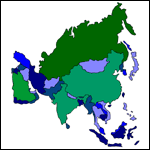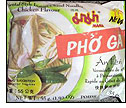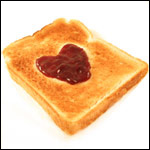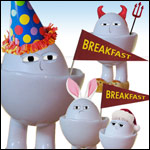Breakfast Articles > World Breakfasts


In this article, we explore the breakfast habits and traditions of seven Asian countries. From expected dishes like rice to unique foods like Deep Fried Devils and fermented cabbage, you'll see that breakfast in Asia is quite varied and very different from breakfast in the United States.
Breakfast In China:
 Chinese breakfast often consists of rice complemented by small amounts of vegetables, meat or fish. Eggs dishes and toast are rarely seen.
Chinese breakfast often consists of rice complemented by small amounts of vegetables, meat or fish. Eggs dishes and toast are rarely seen.In many parts of China, dim sum (translation: "heart's delight") is enjoyed in the morning. Westerners might equate dim sum to a sampler of appetizers. Fried and steamed dumplings are always popular for dim sum.
Congee is popular for breakfast in China and other parts of Asia. This is basically a watery gruel or porridge. It is prepared both savory and sweet and can contain a great variety of ingredients, usually meats, vegetables and herbs that would be considered common for evening meals as well. A somewhat similar soy bean milk soup is also common especially in the home.
Deep Fried Devils are common in China.
 I suppose that sentence deserves further explanation. Deep Fried Devils, or Yu Za Kuei, are twisted strips of dough that have been deep fried. They're similar to crullers except for the fact they are often 12 inches long. The word on the street around 500 BC was that the crullers represented dirty government officials (devils) who wrongly sent a poet, Yueh Fei, to his death for treason. Americans can try to imagine a donut symbolizing George W. Bush or Dick Cheney.
I suppose that sentence deserves further explanation. Deep Fried Devils, or Yu Za Kuei, are twisted strips of dough that have been deep fried. They're similar to crullers except for the fact they are often 12 inches long. The word on the street around 500 BC was that the crullers represented dirty government officials (devils) who wrongly sent a poet, Yueh Fei, to his death for treason. Americans can try to imagine a donut symbolizing George W. Bush or Dick Cheney.Deep Fried Devils are commonly dipped into congee or flavored soymilk just as we'd dip a George W. Donut into a cup of coffee.
Breakfast-on-the-go in China usually means a visit to a street vendor with a portable food stand. They tend to open shop around 5AM and close up by 9AM. A sample menu for a street vendor might include porridge, soup, pancakes (often savory), noodles and Chinese pastries.
One might expect tea to be favored over coffee at breakfast in China. It's true that tea is consumed slightly more than coffee. However due to the high liquid content of most Chinese breakfast dishes, people tend to skip beverages altogether at breakfast time.
Breakfast In Japan:
 The Japanese word for breakfast is "asagohan" which translates to "morning rice" or "first rice". Like so many Asian regions, rice is a major part of breakfast. But in contrast to China, rice in Japan has begun to take a backseat to more western-style breakfasts.
The Japanese word for breakfast is "asagohan" which translates to "morning rice" or "first rice". Like so many Asian regions, rice is a major part of breakfast. But in contrast to China, rice in Japan has begun to take a backseat to more western-style breakfasts.According to a survey of 5,000 people by japan-guide.com, nearly 40% of Japanese citizens regularly enjoy both traditional Japanese and Western cuisine at breakfast. Of the remainder, 24% prefer western-style breakfasts and only 20% still stick with traditional Japanese breakfasts.
According to the survey, the following items (listed in order of popularity) are the most common Japanese breakfast choices: bread, rice, miso soup, yogurt, eggs, natto, jam, sausage/ham, seaweed, pickles, cheese and pancakes.
 The traditional Japanese counterpart to our bacon, eggs and toast would be rice and miso soup. Miso is a soybean paste. The soup is usually prepared by combining the miso with water, tofu, sesame oil and green onions. According to legend, miso was a gift from the gods to ensure humanity's health, longevity, and happiness.
The traditional Japanese counterpart to our bacon, eggs and toast would be rice and miso soup. Miso is a soybean paste. The soup is usually prepared by combining the miso with water, tofu, sesame oil and green onions. According to legend, miso was a gift from the gods to ensure humanity's health, longevity, and happiness. Another traditional Japanese favorite is natto. This unique dish is made by fermenting cooked whole soybeans with a bacterial starter called Bacillus Natto. The resulting beans are then mixed with mustard and a Japanese sauce like soy sauce or Tare. Minced leeks or green onions are often added and the whole mess is served over rice. At other meals, natto is often used as a condiment. To the westerner, the taste of natto may take some getting used to. It's a bit like musty cheese with a hint of ammonia. The mucus-like liquid that forms around the beans doesn't help matters.
Another traditional Japanese favorite is natto. This unique dish is made by fermenting cooked whole soybeans with a bacterial starter called Bacillus Natto. The resulting beans are then mixed with mustard and a Japanese sauce like soy sauce or Tare. Minced leeks or green onions are often added and the whole mess is served over rice. At other meals, natto is often used as a condiment. To the westerner, the taste of natto may take some getting used to. It's a bit like musty cheese with a hint of ammonia. The mucus-like liquid that forms around the beans doesn't help matters.One interesting result of the westernization of Japanese breakfast is the rolled sweet omelet. Imagine a standard Denver omelet. Now, replace the green pepper and onion with pureed fish cake and soy sauce. When the egg has set, roll the omelet instead of folding it. Presto.
Tea and milk are the beverages of choice to accompany a Japanese breakfast. Green tea is most prevalent with English tea coming in a close second. Coffee and orange juice are easy to find if you need your daily infusion of caffeine and Vitamin C. Interestingly, coffee consumption in Japan is 44% higher among company workers.
Breakfast In Korea:
 Korea has a great tradition of breakfast. Centuries ago, Korea barely recognized a lunchtime meal. It was a snack at best. The result was that both breakfast and dinner were grand meals often consisting of several courses.
Korea has a great tradition of breakfast. Centuries ago, Korea barely recognized a lunchtime meal. It was a snack at best. The result was that both breakfast and dinner were grand meals often consisting of several courses.Today, breakfast is still a large meal. A traditional breakfast of Korea consists of rice, a fermented cabbage dish called kimchi, beef and/or fish, a soup made of either beef ribs or pork intestines (tripe) and often a selection of breads and pastries.
 Kimchi is a spicy and very pungent condiment that is served with almost every meal in Korea. It's made by fermenting various vegetables such as cabbage, turnips, onions and radishes with a range of spices such as red pepper powder, garlic and ginger. Homemade kimchi is often placed in tightly sealed jars and buried in the ground for four days or more to ferment.
Kimchi is a spicy and very pungent condiment that is served with almost every meal in Korea. It's made by fermenting various vegetables such as cabbage, turnips, onions and radishes with a range of spices such as red pepper powder, garlic and ginger. Homemade kimchi is often placed in tightly sealed jars and buried in the ground for four days or more to ferment.Long believed to promote intestinal health, there's current growing evidence that kimchi may have played a preventive role in reducing instances of SARS and the Avian Bird Flue in Korea.
If you wake up with a hangover in Korea, give haejang soup a try. Locals will tell you there's no cure better than this curdled beef blood and intestine soup.
On special occasions, rice gruel is often served at breakfast - complemented with fish, abalone, pine nuts and grilled meat, along with a selection of dipping sauces.
A western-style breakfast isn't hard to find in metropolitan areas.
A few other items that find their way onto Korean breakfast tables include: tofu ("tubu" in Korean), red-bean soup, cooked egg on top of rice gruel, pickled vegetables, seaweed, bolgogi (Korean style grilled steak), horicha (cold barley tea) and pajyong (a thin, flat cake of unsweetened batter fried with various ingredients).
Breakfast In Thailand:
 The people of Thailand don't tend to recognize particular dishes as being exclusively associated with breakfast. The items that make up a Thai breakfast are the same items that are eaten during other meals with the slight exception of khao tom - a rice soup similar to China's congee rice gruel. But even khao tom finds itself on a fair number of dinner tables on any given day.
The people of Thailand don't tend to recognize particular dishes as being exclusively associated with breakfast. The items that make up a Thai breakfast are the same items that are eaten during other meals with the slight exception of khao tom - a rice soup similar to China's congee rice gruel. But even khao tom finds itself on a fair number of dinner tables on any given day. Khao tom is usually served one of two ways: as a flavored soup accompanying a number of side dishes; or as flavored soup packed to the hilt with vegetables, meat and other ingredients.
Khao tom is usually served one of two ways: as a flavored soup accompanying a number of side dishes; or as flavored soup packed to the hilt with vegetables, meat and other ingredients.A thicker, more porridge-like variation of khoa tom called johk is also popular.
The Thai version of our donut is called pa thong go. These fried pastries are x-shaped and usually served with soy sauce, sweet soy milk, custard cream or other dipping sauces. At other times of the day, pa thong go are eaten as a snack.
Fresh fruit is common for breakfast when available.
Here are some other items you may find for breakfast in Thailand - and since people in Thailand eat whatever they want, whenever they want, this is basically just a list of Thai food: fried rice, curries , noodles, fried peanuts, pickled vegetables, bbq'd meats, fried grubs, eel, eggs and little rice and coconut puddings called khanom krok.
Before you count Thailand out as kind of boring when it comes to breakfast, consider one last item that they have for breakfast (and lunch and diner). Best served cold, beer is a common breakfast beverage.
Breakfast In Singapore:
 The signature breakfast dish in Singapore is kaya toast. Kaya (pronounced "car-yah") is a jam or paste made from slow-cooking coconut milk, eggs, sugar vanilla and a hint of pandan leaves. It's spread on a slice of toast along with a little butter.
The signature breakfast dish in Singapore is kaya toast. Kaya (pronounced "car-yah") is a jam or paste made from slow-cooking coconut milk, eggs, sugar vanilla and a hint of pandan leaves. It's spread on a slice of toast along with a little butter. When served as part of complete breakfast, the toast is often accompanied by soft-boiled eggs drizzled with soy sauce. Kaya toast is so popular in Singapore that you can now by it at the local McDonalds - a real bummer for smaller breakfast vendors who have been serving the specialty since the 1940s.
When served as part of complete breakfast, the toast is often accompanied by soft-boiled eggs drizzled with soy sauce. Kaya toast is so popular in Singapore that you can now by it at the local McDonalds - a real bummer for smaller breakfast vendors who have been serving the specialty since the 1940s.Roti parathas are another Singapore breakfast favorite. These are fluffy yet crispy pancake-like pastries that are served with spicy curry dipping sauces. They can be prepared on a griddle or deep-fried. They're an especially popular choice when buying breakfast from stalls and street vendors. Most restaurants stop serving roti parathas at noon which make these pastries unique in an Asian culture where most breakfast dishes are readily available as other meals.
Singapore and neighboring Malaysia share another breakfast favorite called nasi lemak. This is rice cooked in coconut milk with pandan leaves and sometimes ginger and lemon grass. It's usually served with chicken, beef or fish. Available from most street vendors, nasi lemak is available all day long.
As in China, dim sum is a common breakfast option. Koo chye kueh (glutinous rice dumplings filled with dried shrimp and chopped chives) and choi pau (vegetarian buns filled with water chestnuts, bean curd and Taiwanese endive) are two Singapore dim sum favorites.
The unique breakfast beverage of Singapore is tong ho choy. It's referred to as a tea, but a westerner would be inclined to call it a soup. It's made from pork rib, various herbs and soy sauce. It can also acts as a dipping sauce for roti parathas or Chinese crullers.
Breakfast In Vietnam:
 When you're talking about breakfast in Vietnam, you're probably talking about one of three things: pho, sticky rice or some sort of French bread.
When you're talking about breakfast in Vietnam, you're probably talking about one of three things: pho, sticky rice or some sort of French bread. Pho (pronounced "fuh") is soup with rice or wheat based noodles that's flavored with a meat such as chicken, pork or beef. Fresh ingredients are added to the soup or act as a topping for the soup. These ingredients may include any combination of the following: preserved cabbage, chopped chilies, roasted peanuts, shallots, bean sprouts, cilantro, basil, lime, Vietnamese parsley and garlic. A fish or chile sauce is almost always served with the soup. Pho makes occasional appearances at other meals as a starter course.
Pho (pronounced "fuh") is soup with rice or wheat based noodles that's flavored with a meat such as chicken, pork or beef. Fresh ingredients are added to the soup or act as a topping for the soup. These ingredients may include any combination of the following: preserved cabbage, chopped chilies, roasted peanuts, shallots, bean sprouts, cilantro, basil, lime, Vietnamese parsley and garlic. A fish or chile sauce is almost always served with the soup. Pho makes occasional appearances at other meals as a starter course.In many rural areas, sticky rice or xoi rules the breakfast table. Often the rice is steamed with brown sugar and mung beans. The rice is then wrapped in coconut or bamboo leaves.
In the late 1800's, the French took over every Vietnamese city they could get their wily hands on. The result of decades of French rule - as it applies to breakfast - is the abundance of French-influenced breads that are still widely consumed in Vietnam. French bread is available in most restaurants. It's common in metropolitan areas to see women carrying burlap bags full of baguettes on their heads to sell on the street. It's even easy to find a good crepe in fancier restaurants.
Fruit is often served as or with breakfast. Mango and dragon fruit - a unique regional fruit from the cactus family - are particularly prevalent.
Breakfast In Taiwan:
 While Taiwan was able to break free from Chinese political control over the last half-century, they haven't yet established their own national identity when it comes to breakfast. Simple egg dishes are a bit more popular in Taiwan (especially simple breakfast sandwiches or "grilled egg sandwiches filled with greasy Spam-like meat on bland white bread" as one reporter put it), but China's morning dim sum is the defining breakfast tradition on the island.
While Taiwan was able to break free from Chinese political control over the last half-century, they haven't yet established their own national identity when it comes to breakfast. Simple egg dishes are a bit more popular in Taiwan (especially simple breakfast sandwiches or "grilled egg sandwiches filled with greasy Spam-like meat on bland white bread" as one reporter put it), but China's morning dim sum is the defining breakfast tradition on the island.Some dim sum breakfast favorites in Taiwan are dan bing (rolled egg pancakes with onion), man tou (steamed bread), fan tuan (rice roll-ups), tang bao (soup-filled dumplings), potstickers and baozi (steamed buns stuffed with pork and vegetables). They're all served with soy sauce or a chili sauce.
China's Deep Fried Devils (crullers) are readily available under the name you tiao.
Tofu served with soy sauce and bits of scallions and chilies is a very simple Taiwanese breakfast.
Morning cup of coffee? A resident of Taiwan would be more prone to have bowl of dou jiang - soybean milk. The milk is served both hot and cold and is often accompanied by a little yellow sponge cake called ma la goa for dunking.
A welcome sight to western travelers, you will occasionally spot a street vendor making made-to-order omelets. You can choose from several fillings: ham, cheese, fresh vegetables, tuna, etc.
A tuna omelet?
Ly yau ve? (Translation: "Are you getting hungry?")
Mr Breakfast's Asian Breakfast Recipe Collection:
Asian Frittata
Asian Omelette
Barley Tea (Korea)
Coconut Rice with Mangos (Thailand)
Honey Ginger Melons
Kao Tom (Thai Breakfast Soup)
Kaya (Singapore Egg Jam)
Korean Kimchi
Miso Soup (Japan)
Natto (Japan)
Okonomiyaki Pancakes (Japan)
Peanut Sticky Rice (Vietnam)
Pine Nut Gruel (Jat Juk)
Rolled Sweet Omelet (Japan)
Spring Onion Pancakes (China)
Spring Onion Scramble (China)
Sweet Potato Congee (China)
Hey traveling breakfast lover! Have you been to this part of the world? Do you have a breakfast experience you'd like to share. Facebook me and I'll put it in the article.
Connect With Mr Breakfast:

Breakfast In Asia
Breakfast In Iraq
Breakfast In Ireland
Breakfast In Germany
Breakfast In Mexico
These are the first in a series of features on international breakfast. Please return to MrBreakfast.com in the coming months as we explore other parts of the world.
Related Links:
International Breakfast Recipes

Holiday Breakfast Traditions

Mr Breakfast Home Page
Related Links:
International Breakfast Recipes
Holiday Breakfast Traditions
Mr Breakfast Home Page
Home | About | Contact | Breakfast Recipes | The Cereal Project | Site Index | Food Charities | Blog
©2025 MrBreakfast.com
©2025 MrBreakfast.com







